Which lithium battery pack for my Tamiya chassis?
Many Tamiya chassis have molded battery trays like these:
M-03 chassis
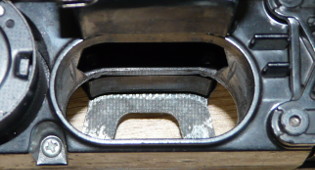
TB-03 chassis
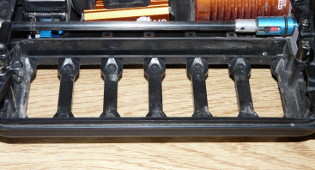
DF-02 chassis
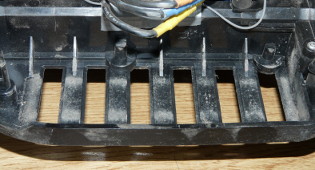
As for the frame-type chassis (M-Chassis, TL-01), the tray is the perfect cross section of a battery pack. On the vast majority of their other chassis, the bottom part of the battery tray is not flat since there are lugs meant to perfectly maintain the battery pack. These solutions are great for the traditional stick format battery packs, even if some modern high capacity NIMH packs tend to be difficult to insert in some chassis battery trays. However, the vast majority of lithium battery packs being rectangular-shaped, either the chassis requires dremel modification to host the new lithium battery packs, or the lithium packs need to be of the stick-shape kind.
Remember, Tamiya solved the problem by adding a range of LiFe packs to their catalog. These are compatible with almost all their current and past chassis:
Tamiya 55105 LF1100
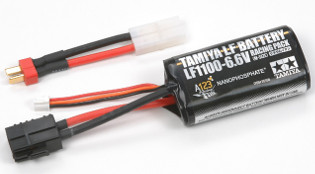
Tamiya 55109 LF1600
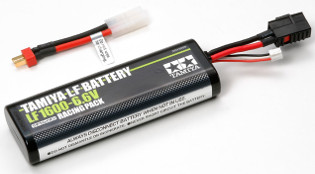
Tamiya 55102 LF2200
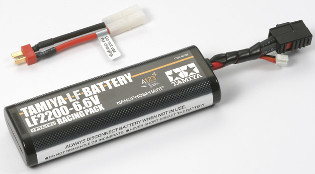
The first "short" one is suited for SRB (Buggy Champ) and RM-01 chassis: it will also suit any vintage chassis originally designed for 6V battery packs (Tyrrell P34, Ferrari 312T3 for example). As for the two others in the traditional stick shape format, Tamiya published a list of compatible chassis with detailed photos on their website. Apart from Tamiya's offering, I am not sure I have even seen other stick shape LiFe packs. OK, I confess I never thoroughly searched for them, but they don't seem very popular either.
One note about the frame-type chassis (M-Chassis, TL-01): the pack transverse position makes it very much exposed to direct hits. Given the possible damages and how dangerous direct hits are for LiFe and LiPo batteries, I confess I still have doubts about using this type of batteries in these chassis. No matter what, they will definitely have to be the hardcase type.
Several manufacturers offer traditional stick shape battery packs using the LiPo technology. Caution though: these packs exist in 134mm long format, but also 136 and 138mm long. Over 134mm long, only a few Tamiya modern chassis can take them. Within 134mm long, there is an "absolute" compatibility (without any modification) with every Tamiya chassis in which you can insert a 6-element stick NiCd or NiMH battery.
 134mm long stick format LiPo 2S battery packs
134mm long stick format LiPo 2S battery packs
Robitronic :
R05220 3000mah 25C
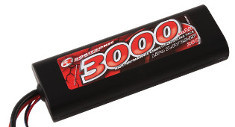
R05221 / R05224 4100mah 25C
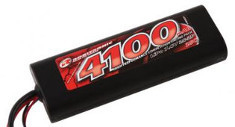
R05222 3600mah 50C
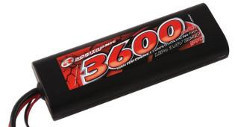
R05223 / R05225 3000mah 20C
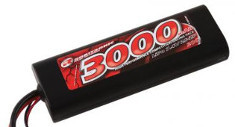
Jamara :
141390 5000mah 30C
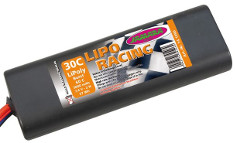
141393 3700mah 30C
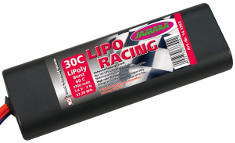
141423 4000mah 30C
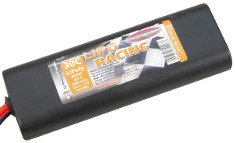
141422 4000mah 30C
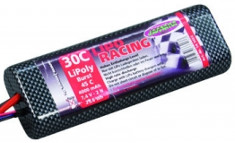
Core-RC :
CR293
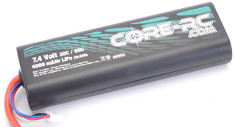
Yuki Model :
Brainergy 801004
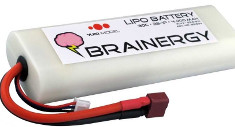
I own the 3000 and 4100mah Robitronic packs, as well as the 5000mah Jamara pack. I tested them in all my chassis in which I used to insert standard 6 elements NiMH stick packs: everything is perfect, they do fit like a charm (unlike some of my NiMH over 4000mah capacity), including in the narrowest chassis trays like on the TA-01, DF-01 and CC-01 (before modification).
Robitronic battery packs: Robitronic packs: so far, they work like a charm and quality seems to be there. Please note that references R05221 and R05224 are the exact same, apart form the connector (Tamiya / Traxxas). Same thing for references R05223 and R05225.
Jamara battery packs: I only own the 5000mah version, but the hardcase is the same on the 3 first packs shown. The 4th one lists the same dimensions, but the case looks different. The claimed 5000mah are just a dream: mine never reached such a capacity, neither those own by a friend of mine. The real capacity seems like it is about 3700mah, whatever the capacity written on the pack label. It wouldn't be much of a surprise if the cells were all the same in all packs, only the labels would change (and the price too). I can not recommend them.
Core-RC battery packs: I've never seen any, so I can't say about quality or true dimensions.
Yuki Model battery packs: one reader tested it and dimensions are strictly compatible with Tamiya chassis. As for quality, it seems to be good and to compare with Robitronic batteries.
The offer in strict classic stick format that is compatible with Tamiya chassis is very limited and only in LiPo (except Tamiya's offering in LiFe). Robitronic and Jamara are manufacturers from Austria and Germany: their products may not be available worldwide (but they can be ordered over internet, unless transportation restrictions apply). Core-RC products can be found in many countries, but there is absolutely no information about who is the real manufacturer. Yuki Model looks like a German company, but their products are distributed in many countries.
Unfortunately, if none of these products is available in your country (or that no one can ship them to your country), then I am afraid you will need to perform tests by your own or stick to NiMH battery packs.
 138mm long stick format LiPo 2S battery packs
138mm long stick format LiPo 2S battery packs
Some manufacturers claim their battery packs to be direct replacements for NiMH sticks, but when you have a closer look to the dimensions (when available), these packs are 138mm long (sometimes even claimed as 136mm long which become 138mm long whenever you take measurements). These packs are too long to be strictly compatible with most Tamiya chassis, even though the oval shape may fit our chassis tray bottoms:
GensAce series 8
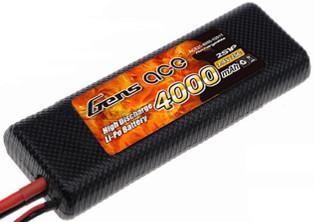
GensAce series 20
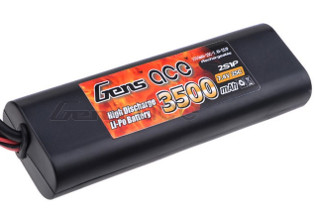
Nosram 99957 3800mah 30C
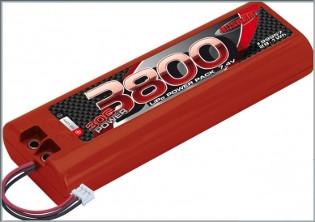
GensAce series 8: I own the 25C 4000mah version claimed to be 136mm long but measured at 138mm long, measures that do correspond to other versions of the series using the same hardcase (2400 and 3000mah, 25C). Caution: on this series, the hardcase bottom has lugs, which is a problem with many Tamiya chassis (in addition to the length problem and the wires located on the side instead of being centered). Sometimes after modifications, this battery pack can be used in these chassis in my collection: TA-04 TRF, DT-02, TB-03, DF-02, FF-01 and Toyota Tom's 84C. It also fits the re-released Avante chassis (possibly the re-released Egress too). It does not fit in any other chassis in my collection. As for quality, GensAce is among the best references on the market.
GensAce series 20: I do not own these, so don't take my word and check by yourself first. The hardcase is different from the series 8 (here with wires centered) and looks like the oval is perfect (no bottom lugs). However, they are listed as 139mm long, which makes them incompatible with many Tamiya chassis.
Nosram : here too, good quality battery that I own. Said to be 138mm long, it is 138mm long. Despite lugs on the bottom of the hardcase, it does fit in many chassis, including the frame-type chassis like the M-03. However, due to the length of the wires and how they get out of the hardcase, this pack can't be considered as compatible with the majority of Tamiya chassis. Sometimes after modifications, this pack fits the following chassis in my collection: TA-04 TRF, DT-02, TB-03, DF-02, FF-01, Wild Willy II and Toyota Tom's 84C. It does not fit in any other chassis in my collection.
To conclude, apart on few recent Tamiya chassis, these too long stick batteriy packs are not very useful. For the best compatibility, the rare strict classic stick format packs are the way to go. For the most modern of Tamiya chassis, brick shape battery packs can fit, offering a much wider choice in terms of quality, price and capacities.
Conclusion
The idea for this article came both from the questions I had when I decided to switch to LiPo for my models, and from the cruel lack of precise information I found about it. The deliberate vagueness about how to use this new battery technology is what first astonished me, then the general level of information of customers (among which I was) worried me. So I began chasing for accurate information, which took me months in order to gather consistent material in order to write this article.
In fact, the consequences of LiPo misuse are far more dangerous than with LiFe. Unfortunately, the overall RC industry sacrificed security to performance induced by the LiPo higher voltage. In my opinion, the manufacturers are irresponsible, thoughtless and prove to truly despise their customers. After reading this guide, have a thought about these shelves full of choppers and drones in your supermarket... those toys used and stored by your neighbors. Now fear! How dreadful and outrageous that even toys for young kids can be so dangerous when safer and less demanding technologies exist. Unfortunately, we have to deal with these unscrupulous manufacturers and we must take all necessary safety measures to enjoy our hobby.
Everything begins at the time of buying battery packs: avoid exotic and unknown brands. Choosing a renown brand is definitely not a guarantee for safety and quality, but the opposite is almost a free ticket to danger. The battery pack shape will of course need to fit the battery trays on your chassis, but above all, the battery pack characteristics will require close attention in order to check if they meet your model(s) power requirements. Only one rule for this: oversize! Of course, this basic security rule has a cost, but your concern must be to reduce risks.
As for using your battery packs, you must respect rules of usage and security:
- correctly setup your charger for each battery pack + charge with balance at 1C maximum in a LiPo Safe Bag
- always recharge your packs within 24h after use
- use the storage mode if you don't plan to use your packs for over 1 to 2 weeks max
- store your battery packs in LiPo Safe Bags or metal boxes (for example, ammo cases available in army surplus)
- store your packs on a non-flammable surface (tiled-floor for example)
- whenever possible, keep them away from kids
- use plugs suited for the voltage your models need
- always use a correctly setup cut-off function or an external alarm device
- immediately stop your model when the alarm beeps or the cut-off activates
- watch your battery packs: as soon as you detect puffing, consider the pack is definitely damaged and dangerous
This list might seem long and binding: in practice, it is only a question of discipline. Ni-Cd and NiMH technologies made us lazy thanks to their great ease of use and security, the biggest risk being a partial or total loss of capacity. To my knowledge, only one series of NiMH battery packs was prone to explode under rare circumstances: the infamous IB4200 couldn't resist abuse (high discharge rates and high voltage charge). But for regular users, NiCd and NiMH technologies were absolutely safe and allowed to be treated without great care: this time is over with LiPo, but also with LiFe (even though the consequences are not so dramatic).
If you can, choose the LiFe technology: even if it requires precautions of use too, a mistake or a lack of care will not turn your model or your home into ashes. Switching to the LiPo technology means advantages (autonomy, performance), but also constraints and risks: either you are self-disciplined enough to use and take good care of them, or I think it would be wiser to keep up with the NiMH technology.
Keep in mind that the one and only thing that counts is safety for yourself and your family: a little dose of elementary discipline will never restrain how much you enjoy RC.




